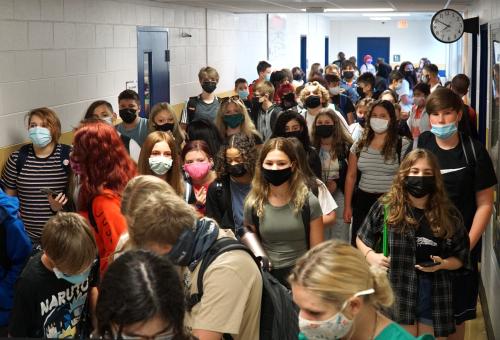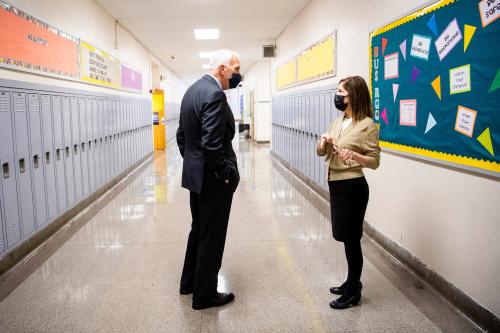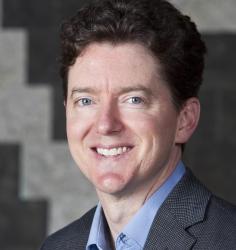As the new year begins—and the Omicron variant spreads—there has been much wrangling about school reopenings. Chicago Public Schools were one of the most prominent examples of districts going remote due to COVID-19 concerns, before returning to in-person instruction this week.
But the critical roles that schools play in our children’s lives—academically, socially, and emotionally—are also becoming more and more evident. Also, if schools take reasonable steps, there is some evidence that they can open safely, with limited health effects. It’s why some say that “schools should be the last to close and first to open.”
Why has this been so hard? The auto supply-chain problem is a useful analogy. By now, we’ve all seen how the prices of cars have gone through the roof. Used cars are sometimes selling for more than they were purchased for when they were new. This is because it’s been difficult for auto makers to produce new cars. Cars have thousands of parts. If only one part is missing, the car won’t work.
So it is with schools. If we want to reopen schools in-person—and I think we can and should in the vast majority of cases—then we have to start with the end in mind and work our way backward to figure out how to do it.
What has to happen for a school to open?
First, almost every one of the dozens or hundreds of people who work in the school has to come to work. If one or two teachers don’t show up, administrators or substitutes can step in, but there is an obvious problem if many teachers don’t show up on the same day. And it’s not just teachers, but the extensive support staff who are essential to making schools work. A missing bus driver means that a large share of students will be stranded. A missing janitor means that the bathrooms are a health hazard. A missing lunchroom helper means there might not be food and/or that teachers must step in and can’t eat or prepare for the next class.
Second, these decisions can’t be made at the last minute. If people don’t know in advance that schools are going to open, then they won’t be able to plan for it and be ready. But COVID-19 is almost designed to make planning difficult. The Omicron variant is spreading fast, and we are still learning about its health effects. There’s no way to know when a few teachers and staff might test positive, so there is constant uncertainty around whether schools can remain open.
Third, school staff with young children have their decisions interconnected with all the other day-care centers and other schools, which might also close. This creates a cascading effect. One closure can trigger others.
That’s the picture at the local school and district level. But state and local public health rules around COVID-19 could also change. This is as it should be—rules should be adjusted as new information comes in—but the fact that school reopening is interconnected with decisions by organizations outside of schools makes it harder. The advantage of local decision-making is that local conditions vary; the disadvantage is that it complicates coordination.
The fourth, and perhaps the most challenging issue of all is that, even when schools do open, many students will not show up for fear of catching COVID-19 themselves and/or passing it on to family members. Others will test positive. These students are going to fall behind unless they are served, and, for all of the above reasons, it’s hard to serve students in-person and remotely at the same time.
These challenges are also larger in public schools and in low-income areas where COVID-19 rates are more dependent on buses and school-provided food. Parent hesitancy is also greater in these areas, often for good reason, when the COVID-19 community spread is higher and health effects are worse. (This is partly why we found in our earlier research that local demographics were stronger predictors of school reopening than things like teacher unions.)
Opening schools during COVID-19 is hard. A thousand things have to go right. But we need to find a way. Schools really are critical for our children—who are falling further behind by the day, with a growing list of long-term repercussions.
What can be done?
With this outline of the challenge, the solutions become a bit clearer.
1) Hire extra back-up staff to prevent shortages. As the above analysis shows, problems will arise. On some days, a lot of staff won’t show up. But funds (including federal dollars) can be used to hire back-ups—and to pay them something even if school staffing needs end up being less than expected. To avoid having to raise base salaries and create longer-term financial problems, schools can also pay bonuses to attract these workers on a short-term basis.
2) States, especially governors, need to step up and play a stronger leadership role. When there is a large number of interconnected decisions, as is the situation here, decentralized decision-making to schools and districts isn’t going to end well. When one day care or school decides to close, this makes it harder for the others to stay open (e.g., because each one serves students whose parents work for other day cares and schools). There is also a psychological effect where one day-care closure makes it more likely that others will think to do the same. When this happens, each closure precipitates others, like falling dominoes.
To keep the first dominoes from falling, leadership and coordination are necessary. Governors are uniquely positioned for this. Governors can set expectations for the entire state—all schools and day cares. Also, the governor, along with state departments of health and education, can follow the governor’s lead and work to facilitate school access to PPE, tests, and vaccinations—still the key tools in the COVID-19 toolbox. Remarkably few states are even requiring masking in schools (and some are actually banning them). This lack of leadership is making it harder for schools to stay open or reopen if they close. Masking and testing are effective tools for preventing COVID-19 infection and for making people more comfortable in coming to school.
Some national leaders, especially leaders of teacher unions, can also play an important role in this. What could be useful is more governors standing up at the podium, hand in hand with teacher union heads, and having them both say, “Let’s find a way to open schools safely.” That may seem politically unlikely, given the hesitancy of many teachers to return, but it’s worth pointing out that part of what is making this so stressful for teachers is the lack of day care and broader coordination that this step could help address.
3) Set a clear expectation in advance that schools will open and have clear contingency plans. Again, this is much easier with state-level leadership, so that everyone has the same expectation and can plan for it in advance. There are also extreme conditions under which schools will have to close, and states and schools should be clear about what those are. That kind of transparency can also increase trust and make it easier to open when conditions allow.
4) Require COVID-19 testing and masking so that everyone is safer, and feels more comfortable, being in school. This makes it less likely that people will get sick, and more likely that hesitant teachers, support staff, and students will show up. Of course, this only works if state and federal governments have done their jobs to make PPE, tests, and vaccines widely available.
What about vaccine mandates? If society’s ever going to get out from under the COVID-19 cloud, we’ll eventually need to require the COVID-19 vaccine for all students and staff—as most schools have for almost a century with vaccines for measles, polio, and so on. My hometown of New Orleans was the first to impose this, and it’s not hard to see the benefits: It encourages vaccination and allows everyone to come to school safely.
In other places, it might be better to wait a bit, however. Though the vaccine is safe and effective, hesitancy is high enough in some places that a vaccine requirement at this stage would lead large numbers of students and staff to opt out. While it’s tempting to think, “That’s their problem,” it’s important to remember that parents are often making this decision on behalf of their children. Additionally, it’s a problem even for vaccinated students whose education would suffer from opt-outs. In the short run, staff opt-outs will make it harder for schools to serve students. In the long run, once all students return, opt-out students will have fallen behind and require extra attention. Whether required now or later, schools should encourage students and their families to get vaccinated now and hold vaccine drives to increase vaccination rates.
The school reopening decision is complicated, just like the auto industry’s supply-chain problem. But we also know what it takes to succeed—strong leadership, clear expectations, and strategic use of resources. While this might also seem too late, it appears that COVID-19 is going to be with us for another year or longer. Children need us to do better than we have so far.






Commentary
Keeping schools open during COVID-19 is hard, but it can be done
Here’s what has to happen to maintain safe in-person learning
January 11, 2022